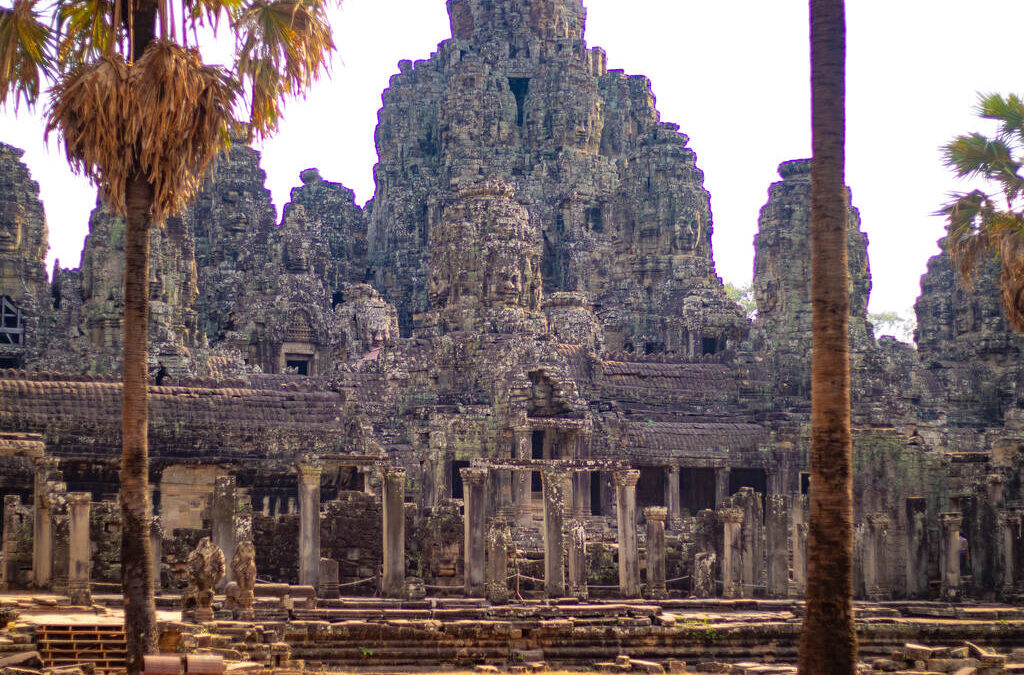If you strolled through ancient Angkor, you’d spot rice paddies, wooden houses on stilts, and wild markets buzzing by sparkling reservoirs—a city design all about managing water! You’d bow to the all-powerful god-king, see priests run sacred temples, and watch market women haggle over imported gold and local fish. Daily life meant communal family meals, working fields, and grand rituals under temple towers. Tempted by stories of droughts, invasions, and change? There’s so much more just ahead!
Key Takeaways
- Daily life revolved around sophisticated water management, with canals, moats, and huge reservoirs supporting farming and urban living.
- Society was strictly hierarchical, led by a god-king, with nobles, priests, commoners, and slaves each having defined roles and privileges.
- Most people lived in simple stilted wooden houses, sharing meals and chores within extended families.
- Markets buzzed with trade in rice, fish, crafts, and imported luxuries, connecting Angkor to wider Asian networks.
- Temples served as spiritual centers, hosting elaborate rituals and symbolizing the divine order of the universe.
Urban Planning and the Water City
Imagine a city where water isn’t just a necessity—it’s the heart of everything. That’s Angkor!
You’d walk through streets planned with mind-blowing precision, knowing the whole urban design revolves around water management. Giant reservoirs called barays—like the West Baray, with a whopping 50 million cubic meters of storage—were everywhere, collecting monsoon rains and feeding canals that crisscrossed the city.
No need to worry about drought or floods—these folks planned for both. You’d see canals for transportation, ponds for daily use, and moats wide enough to make enemy invaders think twice.
Even the city’s layout symbolized Hindu and Buddhist beliefs, with moats as cosmic oceans! Imagine living surrounded by rice paddies integrated right into the city—ultimate freedom and fresh food!
Social Structure and Hierarchy
Even before you set foot in ancient Angkor, you’d notice something clear as day: this city was all about status and who fit where in the grand pecking order. There was a super rigid royal hierarchy—think god-king on top, everyone else scrambling below. Your social roles weren’t just a suggestion, they defined almost everything about your daily life. Here’s a quick guide:
| Stratum | Description |
|---|---|
| God-King & Royals | Divine, ruling, loaded with power & luxury |
| Nobles & Priests | Ran provinces, led rituals, lived fancy |
| Commoners | Built, paid taxes, made the kingdom run—unsung! |
| Slaves | Did grunt work, zero freedom, owned by the wealthy |
If you craved freedom, let’s be honest—you’d avoid the bottom of this ladder!
Work, Craft, and Market Life
Life in Angkor didn’t run on royal decrees alone—the city’s heartbeat came from all the buzzing work down in the fields, workshops, and markets.
Imagine waking up at dawn to the energy of rice farmers paddling knee-deep in wet fields or fishermen reeling in catches from the Tonlé Sap. The place thrived on specialized artisan techniques—think master stone carvers shaping temple walls or silk weavers crafting vibrant tapestries.
You’d see market women, sharp-eyed and resourceful, laying out mats and running things like pro traders, all while bartering rice or imported Chinese fabrics. Angkor’s trade networks connected your city to India, China, and beyond!
Goods like rare woods, spices, and even elephant tusks flowed out, while gold, silver, and gorgeous ceramics poured in. Freedom meant hustle and creativity!
Houses, Families, and Daily Routines
While palaces dazzled with stone and tiles, most folks in Angkor called humble, stilted wooden houses “home.”
Step into a neighborhood and you’d spot simple dwellings made from bamboo and palm, standing high above the floodplain—easy to enter if you’re up for a ladder climb!
Stilted bamboo and palm houses towered above the floodplain, inviting you up a ladder to everyday Angkorian life.
Housing styles varied, from single-room huts to larger Pteas Rongdeung houses for extended families.
Status really showed: only officials got tiled roofs, while you’d rock thatched ones.
Inside, don’t expect much—think mats, earthen pots, and coconut utensils.
Family dynamics? Three generations could share one roof, from grandparents to grandkids.
Meals meant rice, fish, and veggies, eaten with your hands.
After chores, unwind with a board game or stories under the stars.
Life was simple, lively, and community-centered!
Temples, Rituals, and Sacred Spaces
Stroll beyond the buzz of neighborhood chatter and laundry hanging outside those wooden homes, and you’ll hit the real heart of Angkor: its breathtaking temples.
Here, temple symbolism is everywhere—see those moats? That’s not just for show. They represent the cosmic ocean!
Step inside and you’ll notice massive towers rising like Mount Meru, said to be the gods’ home.
Circumnavigate the galleries, and you’re walking through the very layout of the universe—how’s that for spiritual freedom?
Ritual practices buzz all around: priests offer prayers, kings get crowned as god-kings, and dancers spin through firelit ceremonies.
Water’s sacred, so every splash in a temple pond means something.
No matter what gods you back, these spaces pull you in.
That’s ancient Cambodia—limitless and alive!
Change, Challenge, and the Fall of Angkor
Even the most dazzling kingdoms can run into real trouble—and Angkor was no exception. Imagine watching your home’s water system break down just as droughts and wild floods hit hard. Environmental degradation became a nightmare: forests stripped, soil turned to mud, and rice fields clogged with silt. When your canals can’t deliver water, you’re stuck! And shifts in belief rocked society—Theravada Buddhism’s spread meant old power structures cracked wide open. Meanwhile, outside threats were knocking (and sometimes kicking down the door).
Here’s how it all shook out:
| Challenge | Impact | Consequence |
|---|---|---|
| Drought/Floods | Broken canals | Food shortages |
| Forest loss | Erosion, silt | Unworkable fields |
| Religious change | Societal transformation | Lost royal influence |
| Foreign attacks | Raids, conquest | Capital’s final fall |
Big problems, big changes—freedom meant adapting fast!
Conclusion
So, if you’d lived in ancient Cambodia’s capital, you would’ve walked wide city streets, dodged elephants, and probably carried water buckets from those mind-blowing reservoirs—some over 8 KM long! You’d feel the energy of marketplace chatter, strict social rules, towering temples, and bustling family life. But even these impressive engineering feats couldn’t stop Angkor’s fall. Next time you sip water, remember: their world was both genius and fragile—just like ours today!



